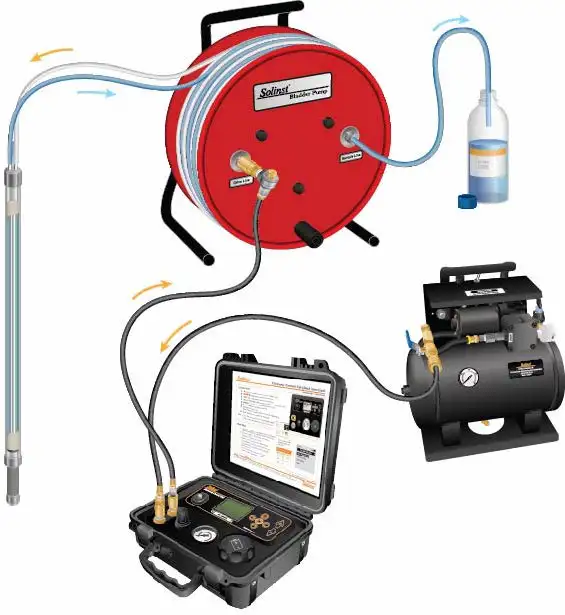| Download Technical Bulletin |
Representative Samples
A project manager’s goal for groundwater sampling is to collect samples that are representative of actual in-situ conditions, and to maintain sample integrity by minimizing the changes in sample quality and chemistry during collection. Sampling has evolved from earlier techniques of bailing and high rate pumping, to techniques of minimal drawdown and low flow pumping.
Low flow pumping has been proven to provide consistent, highly representative groundwater samples. By maintaining flow rates of 500 ml/min or less, sample extraction is kept at a rate comparable to ambient groundwater flow and drawdown is minimized, thus reducing turbidity and disturbance in the well. Reduced agitation is particularly important for accurate measurement of dissolved volatile organic compound (VOC) concentrations in groundwater; too much agitation can cause degassing of VOCs to the atmosphere.
High Quality Pumps
Solinst Bladder Pumps meet US EPA guidelines for low flow and VOC groundwater sampling. Chemical concentrations of VOCs can be easily lost through vaporization if the sample comes into contact with air. Bladder Pumps provide assurance that there is no contact between the sample water and the drive gas.
When in a well, hydrostatic pressure fills the pump’s bladder. Drive gas is applied, which fills the area around the bladder and closes the bottom check valve. Compression of the bladder forces water up into the sample tubing. During a vent cycle, the top check valve closes, keeping water in the sample tubing. The bottom check valve opens and water again enters the bladder. The drive gas never comes in contact with the sample.

Portable Bladder Pump Groundwater Sampling Setup
Application
Solinst Bladder pumps are suitable for use in various environments and applications, including municipal, industrial, and general environmental site assessments.
As an example, a Brownfield site with contaminated groundwater is set for redevelopment. It is imperative to acquire accurate samples of VOC concentrations from an on-site groundwater monitoring well in order to properly address exposure and remediation concerns. The depth to water in the well is 95 ft. (29 m) with the screened interval at 100 to 105 ft. (30 m to 32 m) below ground surface.
A stainless steel Bladder Pump (1.66″ (42 mm) ø or 1″ (25 mm) ø) with a Santoprene® bladder is ideal for this application. The Solinst Model 464 Pump Control Unit is used to control the supply of compressed gas to the pump. The Control Unit, along with a Solinst 12 Volt Air Compressor, allows very slow compression of the bladder, which creates ideal sampling conditions for representative samples.
The Model 464 provides 125 psi output and can be set to sample at 100 ml/min or less. To obtain a sample from the middle of the screened interval, or slightly above (about 102 ft. (31 m)), the Control Unit should be set to output at least 50 psi, as it takes about 1 psi to raise a column of water 2 ft (0.6 m).
To achieve a low flow rate, careful attention is required to choose the correct drive/vent cycle. The Model 464 has preset sampling modes to choose from. The low flow preset has a 50 second drive time that results in slow compression of the bladder, and a 25 second vent period to allow steady refill of the bladder. Alternatively, to adjust the flow rate to better suit the site, a unique drive/vent cycle can be created and saved in the Control Unit memory. The saved flow rate setting can be used each time that well is sampled.
Another well on site is known to contain corrosive contaminants of concern. To get accurate samples here, it is best to use a PVC Bladder Pump (1.66″ (42 mm) ø) and Santoprene bladder. The bladder is very simple to replace in the field – no tools required – so decontamination and reuse is not an issue. In both cases, dedicating a pump to each well avoids cross contamination, and also reduces column disturbance that can be caused by repeated lowering of the pumps.
Conclusion
Overall, high quality groundwater sampling requires preparation, the proper technique and the right equipment. To meet the needs of project managers, Solinst offers convenient sampling solutions for various applications, especially where VOC analysis is the focus.
